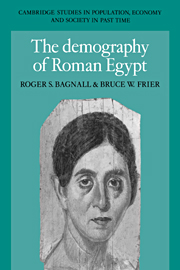Book contents
- Frontmatter
- Contents
- List of figures
- List of tables
- Foreword
- Preface
- A note on references and abbreviations
- 1 The census returns
- 2 The census returns as demographic evidence
- 3 Households
- 4 Female life expectancy
- 5 Male life expectancy and the sex ratio
- 6 Marriage
- 7 Fertility
- 8 Migration
- 9 Conclusion
- Catalogue of census declarations
- Catalogue of census declarations Supplement
- Appendixes
- Bibliography
- Index
- Cambridge Studies in Population, Economy and Society in Past Time
8 - Migration
Published online by Cambridge University Press: 06 January 2010
- Frontmatter
- Contents
- List of figures
- List of tables
- Foreword
- Preface
- A note on references and abbreviations
- 1 The census returns
- 2 The census returns as demographic evidence
- 3 Households
- 4 Female life expectancy
- 5 Male life expectancy and the sex ratio
- 6 Marriage
- 7 Fertility
- 8 Migration
- 9 Conclusion
- Catalogue of census declarations
- Catalogue of census declarations Supplement
- Appendixes
- Bibliography
- Index
- Cambridge Studies in Population, Economy and Society in Past Time
Summary
Migration is the third major demographic function, along with mortality and fertility. In pre-modern populations, migration over very long distances (between countries, or, in historical empires, between provinces) usually had slight impact since populations were largely sedentary. But internal migration over shorter distances, for instance between an urban center and the surrounding countryside, could play a major role in shaping the demographic characteristics of a population.
It may help to have some advance idea of what we might expect regarding internal migration. Late medieval Tuscany exhibits a fairly typical pattern:
Migration into the towns reduced the number of young adult males in rural areas, enlarged their numbers in the cities, and worked overall to even out the rural sex ratios … [T]he towns were lacking in girls and young women, but claimed numerous young males, many of them immigrants. The pattern changes in later life. The influx of males into towns slackened, but that of females increased. Old, often widowed, women from the countryside sought out the amenities and services which towns provided more readily than villages … The attractiveness of cities to older women is a near constant of social history.
As will emerge below, this pattern is at least partly found in Roman Egypt as well.
- Type
- Chapter
- Information
- The Demography of Roman Egypt , pp. 160 - 169Publisher: Cambridge University PressPrint publication year: 1994

